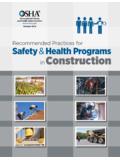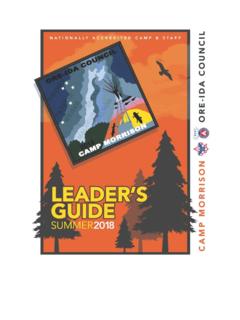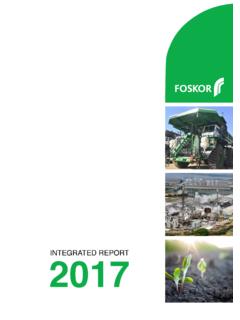Transcription of BY ORDER OF THE AIR FORCE INSTRUCTION 32 …
1 BY ORDER OF THE SECRETARY OF THE AIR FORCE AIR FORCE INSTRUCTION 32-1064 29 DECEMBER 2016 Civil Engineering ELECTRICAL SAFE PRACTICES COMPLIANCE WITH THIS PUBLICATION IS MANDATORY ACCESSIBILITY: Publications and forms are available on the e-Publishing website at for downloading or ordering. RELEASABILITY: There are no releasability restrictions on this publication. OPR: AF/A4CS Supersedes: AFI32-1064, 17 January 2015 Certified by: AF/A4CS (Col Laurie K. Richter) Pages: 24 This INSTRUCTION implements Air FORCE policy directive (AFPD) 32-10, Installations and Facilities. It assigns responsibilities to personnel who maintain and operate electrical systems, including airfield lighting, and facilities.
2 Unified Facilities Criteria (UFC) 3-560-01, Electrical safety , O&M, provides additional safety requirements. This publication applies to all Air FORCE , Air FORCE Reserve Command (AFRC), and Air National Guard (ANG) units and personnel. This publication may be supplemented at any level, but all direct Supplements must be routed to the Office of Primary Responsibility (OPR) of this publication for coordination prior to certification approval. The authorities to waive wing/unit level requirement in this publication are identified with a Tier ( T-0, T-1, T-2, T-3 ) number following the compliance statement. See AFI 33-360, Publications and Forms Management, for a description of the authorities associated with the Tier numbers. Submit requests for waivers through the chain of command to the appropriate Tier waiver approval authority, or alternately, to the Publication OPR for non-tiered compliance items.
3 Refer recommended changes and questions about this publication to the OPR using the AF Form 847, Recommendation for Change of Publication; route AF Forms 847 from the field through the appropriate functional chain of command. Ensure all records created as a result of processes prescribed in this publication are maintained in accordance with Air FORCE Manual (AFMAN) 33-363, Management of Records, and disposed of in accordance with the Air FORCE Records Information Management System (AFRIMS) Records Disposition Schedule (RDS). The use of the name or mark of any specific manufacturer, commercial product, commodity, or service in this publication does not imply endorsement by the Air FORCE .
4 2 AFI32-1064 29 DECEMBER 2016 SUMMARY OF CHANGES This revision updates AFI 32-1064 by (1) changing application and scope for contract work to apply when incorporated into the contract documents; (2) adding an OSHA reference for confined space requirements to include new rule 29 CFR 1926 subpart AA; and (3) removing reference to AFI 32-1063, Electric Power Systems, and ETL 11-9, Electrical Manhole Entry and Work Procedures from the Glossary of References and Supporting Information. Finally, the AF Form 1213, Civil Engineer Energized Electrical Work Permit, is now required for approving energized work meeting the intent of NFPA 70E and the Air FORCE Risk Management Framework.
5 AFI32-1064 29 DECEMBER 2016 3 Chapter 1 APPLICATION AND SCOPE Application and Scope. Application and Scope. This INSTRUCTION applies to all electrical work done either in house or by contract when incorporated as a part of the contract documents on infrastructure and facilities that are maintained and operated by the Air FORCE , assigns supervisor responsibilities and provides necessary guidance to safely build, operate, and maintain electrical distribution systems and equipment. It complies with AFI 91-203, The Air FORCE Consolidated Occupational safety INSTRUCTION , and incorporates National Consensus Standards. Other requirements for worker safety are in UFC 3-560-01. 4 AFI32-1064 29 DECEMBER 2016 Chapter 2 SUPERVISOR RESPONSIBILITIES Personal safety .
6 Supervisors must provide a safe and healthful work environment . (T-0). Supervisors must ensure facilities, work areas, equipment, and work procedures comply with safety , fire, and health policies. (T-0). Each supervisor must be thoroughly familiar with safe working practices, particularly those in UFC 3-560-01 and applicable standards and codes referenced in Attachment 1 of this AFI. (T-0). Supervisors must report and document all injuries, even minor ones, as directed in AFI 91-202, The US Air FORCE Mishap Prevention Program and AFI 91-204, safety Investigations and Reports. (T-1). Planning and Worker Awareness. Supervisors must plan the work properly and ensure it is performed safely.
7 (T-0). Supervisors must review job requirements with the workers and ensure they understand why and how to do the work, the hazards they may encounter and how to control them, and the proper procedures for working safely. (T-0). When the mission allows, coordinate de-energizing of circuits for safest possible working conditions. Supervisors are required to provide written procedures when working on energized circuits to ensure safe practices. (T-0). Training Assistance. Supervisors will provide general and specific safety instructions and training to workers, ensure each employee has access to this INSTRUCTION and UFC 3-560-01, and ensure they demonstrate satisfactory knowledge before performing any task.
8 (T-0). Supervisors must document all training on AF Form 55, Employee safety and Health Record or an alternative as permitted in AFI 91-202. (T-2). Supervisors will, after initial job safety training, train employees annually on lock out/tag out, safe clearance, confined spaces entry, manhole, pole top and bucket truck rescue, shop operating instructions and review any Air FORCE mishap reports. (T-0). Supervisors must instruct employees on identifying abnormal or hazardous existing conditions ( , switches left in an abnormal condition or bypassed, broken equipment temporarily fixed, changes to the one-line distribution map or schematic diagram, lock out or safe clearance tags left on unfinished jobs). (T-1).
9 safety Meetings. Supervisors will conduct weekly safety meetings. (T-2). As a minimum, safety meetings should cover the following topics annually: Hazardous Energy Control (lockout/tagout). Selected safety rules (two or three). Methods and hazards of jobs in progress. Unsafe practices and common causes of mishaps. Recent accidents. Potential personal injuries. Personal Protective Equipment (PPE). Electrical tools. AFI32-1064 29 DECEMBER 2016 5 Materials handling. Good housekeeping. Adequate illumination. Working on or near machinery. Ladders. Working in elevated positions. Lifting and hoisting equipment, including aerial lifts. Grounding systems. Working in underground facilities (confined spaces).
10 Overhead lines. First aid. Rescue and resuscitation. Arc Flash Hazards. Hazards associated with working on or near energized lines or equipment. Abnormal or hazardous existing conditions. Equipment ratings ( amp rating, interrupt rating, short circuit current rating (SCCR) and available interrupting current ratings (AIC)). Energized work and the Air FORCE Form 1213. Specific Job-Related safety Training. Supervisors must instruct employees who handle hazardous materials to include personal hygiene and protective measures in their safe handling of potential hazards. (T-0). Supervisors must ensure Material safety Data Sheets (MSDS) or safety Data Sheets (SDS) are available for all hazardous chemicals according to AFI 90-821 (T-1).
















